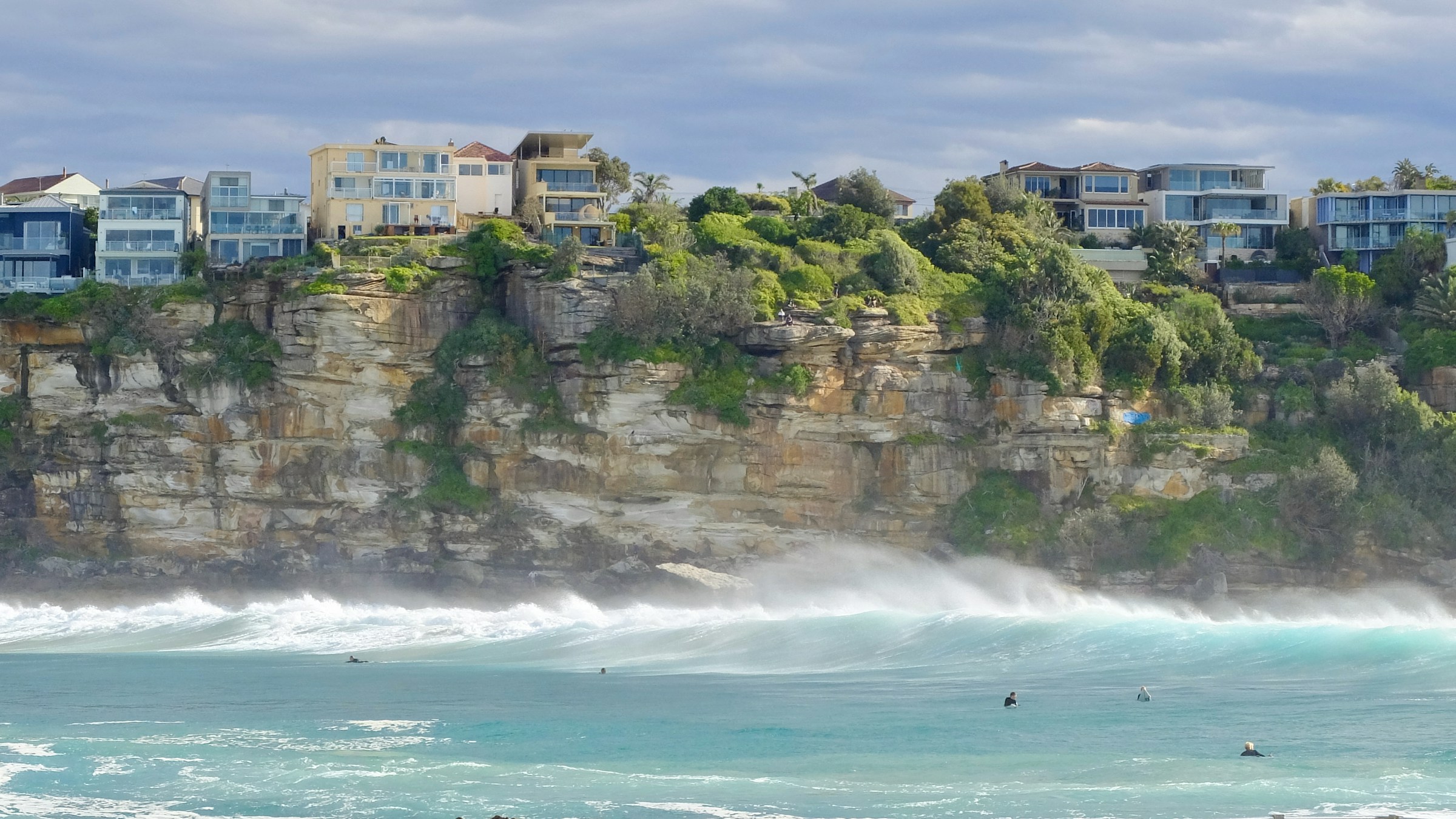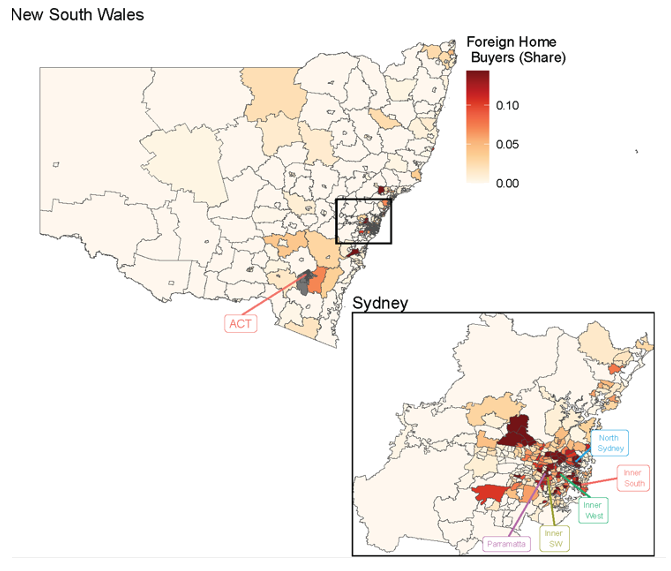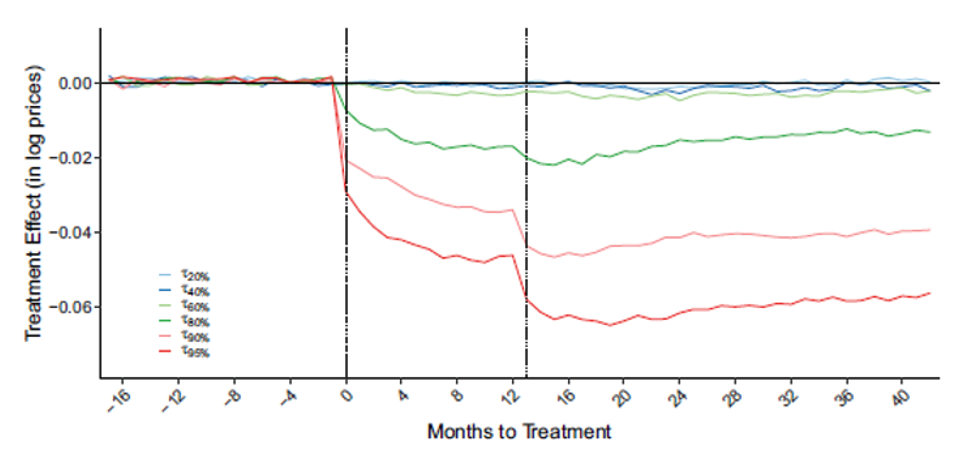Housing prices have soared in major cities around the world. In Australia, this is particularly true in Melbourne and Sydney, where prices jumped by 120% and 111%, respectively, from 2002 to 2016. Some people blame foreign investment in luxury homes for these price increases and the resulting housing affordability crisis.
But is this blame justified? Our new research looks into how foreign buyers affect the housing market in Australia.
The NSW housing market and taxes
There are reasons to believe that foreign buyers might be influencing the overall housing market. In New South Wales (NSW), most foreign demand for residential properties is focused in Sydney. Figure 1 shows where foreign sales occur across the state and within Sydney, clearly indicating that certain neighbourhoods attract a lot of attention.
Figure 1: Location and concentration of foreign-buyer transactions in NSW
Note: Transactions involving foreign buyers occurred between June 2016 and December 2019. Data sourced from the Foreign Investment Review Board.
To reduce foreign demand and relieve pressure on housing prices, NSW introduced a four per cent surcharge on stamp duty for foreign buyers in June 2016. This tax specifically targets foreign individuals purchasing residential properties. It applies to the total value of the transaction and is paid in addition to the regular stamp duty that all buyers must pay.
The goal of the foreign surcharge stamp duty is to make housing more affordable by limiting foreign demand for residential properties. However, not all policies achieve their intended results; some can have negative consequences. For example, this tax might lead foreign buyers to enter the rental market instead or choose cheaper homes instead of higher-priced ones, which could worsen housing affordability.
Our research looks at how foreign surcharge stamp duties affect different segments of the housing market. Specifically, we examine how the tax impacts home prices at various price points. Here are our key findings:
- The tax lowers house prices in NSW, but only for more expensive homes in high-priced neighbourhoods of Sydney.
- Foreign investors tend to leave the NSW housing market in response to the tax, and they do not switch to buying lower-priced homes.
- Overall, while the tax helps discourage foreign buyers from accumulating luxury properties, it does not improve housing affordability for those looking for homes outside the high-end market in Sydney.
Analysing the effects of the tax
To understand how the foreign surcharge stamp duty impacts housing prices in NSW, we compare prices before and after the tax was introduced.
To account for changes in prices that might have happened regardless of the tax, we also look at housing prices in the neighbouring Australian Capital Territory (ACT), which did not have this tax during the same period. This helps us determine the effect of the foreign surcharge stamp duty on housing prices in NSW.
Since foreign buyers usually target high-value properties, we estimate the price effects across different sales values using a statistical method called Unconditional Quantile Regression. Figure 2 reports the results for the 20th, 40th, 60th, 80th, 90th and 95th percentiles.
Figure 2: Effects of the foreign surcharge stamp duty on housing prices
Notes: Figure 2 illustrates the treatment effects on house prices across various percentiles, using log monthly house prices as the outcome measure. The first vertical dashed line at 0 marks the introduction of the foreign surcharge stamp duty in June 2016. The second dashed line indicates when the tax rate was doubled in July 2017.
Before the foreign surcharge stamp duty was introduced, the treatment effect estimates shown by the coloured lines in Figure 2 were close to zero. This means there were minimal price differences between the ACT and NSW. This trend continues after the tax was implemented for lower-value sales at the 20th, 40th, and 60th percentiles of the price distribution, indicating that the tax had no significant impact on lower-priced homes.
In contrast, we see a drop in prices for higher-priced homes after the foreign surcharge stamp duty was introduced, with the decline being more pronounced at the top percentiles. Our calculations show that the tax led to average price decreases of $7,593, $26,696, and $47,899 for homes in the 80th, 90th, and 95th percentiles, respectively.
We also looked at how this tax affects different regions. Our analysis shows that the impact of the foreign surcharge stamp duty on prices is limited to Sydney and primarily affects high-value transactions.
Additionally, we observe a decrease in the number of transactions, particularly in areas where home prices have dropped substantially. This suggests that foreign buyers are not switching to lower-priced properties in response to the tax; instead, they are leaving the Sydney (and NSW) market entirely.
What this means for policy
Our findings underscore the limitations of using foreign surcharge stamp duties to enhance housing affordability. While the tax led many foreign buyers to leave the residential real estate market, the resulting drop in home prices was modest and mainly affected the high-end segment of the market. Importantly, the tax did not change the median home price in the state.
There is a possibility that the foreign surcharge stamp duty in NSW could indirectly influence housing prices. For example, if the government used the revenue from this tax to fund initiatives aimed at improving housing affordability for residents. However, it is unclear whether a tax that significantly changes behaviour is the most effective and fair way to raise such funds.









Recent Comments